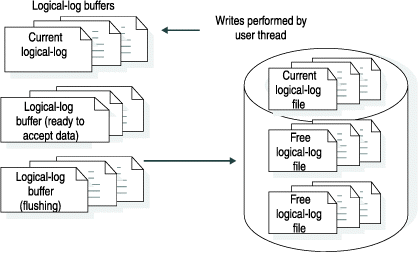
The database server uses the logical log to store a record of changes to the database server data since the last dbspace backup. The logical log stores records that represent logical units of work for the database server. The logical log contains the following five types of log records, in addition to many others:
The database server uses only one of the logical-log buffers at a time. This buffer is the current logical-log buffer. Before the database server flushes the current logical-log buffer to disk, it makes the second logical-log buffer the current one so that it can continue writing while the first buffer is flushed. If the second logical-log buffer fills before the first one finishes flushing, the third logical-log buffer becomes the current one. This process is illustrated in Figure 38.

For a description of how the database server flushes the logical-log buffer, refer to Flushing the Logical-Log Buffer.
The LOGBUFF parameter in the ONCONFIG file specifies the size of the logical-log buffers. Small buffers can create problems if you store records larger than the size of the buffers (for example, TEXT or BYTE data in dbspaces). For the possible values that you can assign to this configuration parameter, refer to the IBM Informix: Administrator's Reference.
For information on the impact of TEXT and BYTE data on shared memory buffers, refer to Buffering Simple-Large-Object Data Types.
Home | [ Top of Page | Previous Page | Next Page | Contents | Index ]